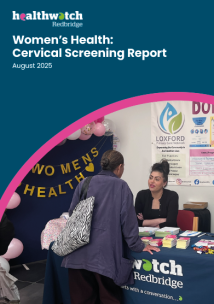Women's Health: Cervical Screening Report

The Healthwatch Redbridge (HWR) Women’s Health Project was established in 2024, to engage with and hear from all women about their experience and understanding of women’s health provision in Redbridge and use these insights to influence and affect change.
The research project has been designed in 3 phases over 2024 – 2025:
- Phase 1: Cervical Screening
- Phase 2: Breast Screening
- Phase 3: Perimenopause and Menopause
Background
In 2024, Healthwatch England asked us to interview women in Redbridge about their experiences as part of an investigation into declining cervical screening rates.
We spoke to local women about their hesitancy to attend screenings, their experiences at screenings and the impact on their health.
We heard how appointment letters were inaccessible, how poor communication about the procedure from services led to fear and uncertainty for women with learning disabilities and how misconceptions prevented women from different communities across Redbridge from attending.
At HWR we believed that the important insights garnered from a small sample of women in our community highlighted issues that warranted further examination.
Expanding on our initial conversations with local women, the research for Phase 1 consisted of extensive outreach and engagement work, visiting 17 community hubs to deliver presentations providing trusted health information, collaboration with health professionals and 48 in-depth interviews with women across Redbridge about their personal experiences of cervical screening.
The report findings reveal barriers that will require system wide change, and co-operation from service providers and community organisations across Redbridge, at all levels.
Report Findings
Invitation to screenings: The data collected from various global communities highlight significant disparities in cervical screening uptake. Our findings recorded much lower response rates amongst Learning Disabled (LD) women (25%) and wheelchair users (40%)
Translated Information: African/African Caribbean (36%), Bengali (22%), Romanian (66%), Somali (41%), stated they would want information in their own languages so they were more informed about the procedure and could make informed choices.
Improvement to provision of information: Over half of women (55%) from the LD community and wheelchair users reported there was lack of accessible information.
Speculum Sizes: A third of all women interviewed (34%) reported that they did not know that different speculum sizes were available which could improve their overall screening experience.
Accessibility: Women who are wheelchair users reported a lack of reasonable access within practices and poor understanding of their conditions when communicating with health professionals.
Health Literacy: Most participants (91%) reported that health literacy was an issue, such as not knowing what Human Papillomavirus (HPV) was, and what the screening would look for.
Patient experience: Some individuals reported services having a poor approach to culturally sensitive beliefs and practices and lack of trauma informed care.
Home Testing Kits: Many participants (39%) reported they were willing to use home testing kits when they are rolled out by the NHS.
Recommendations
Improvement of access and person-centred service provision
- Ensure staff are well-trained in culturally sensitive, trauma-informed care and represent diverse communities.
- Tailor strategies to prevent women in temporary accommodation missing screenings due to relocations.
- Provide flexible appointment options for women, outside of standard working hours.
- Expand outreach to community-based services ensuring invitations reach eligible women from seldom heard communities in a timely way.
- Improve accessibility of clinics and equipment across health centres and GP surgeries.
- Promote home testing kits by running national and local campaigns to inform people about the availability and ease of using testing kits at home.
Information & Awareness
- Improve information provision with feedback mechanisms in patient forums.
- Co-design materials and services for women with community organisations.
- Ensure translated materials readily available and use community health workers to engage with communities.
- Eradicate misconceptions through educational campaigns in community hubs, ensuring all women receive the necessary care.
- All communication in Redbridge must consistently include AIS-approved standard information to ensure equity of access and inclusion for all women.
Data Quality
- Data recording needs to improve particularly in capturing information related to ethnicity and disability providing valuable insights into healthcare inequalities to ensure fair access to services and tailor interventions to meet the needs of diverse populations effectively.
Download the report
If you would like this report in another format, please get in touch:
Email: info@healthwatchredbridge.co.uk
Phone: 020 8553 1236

